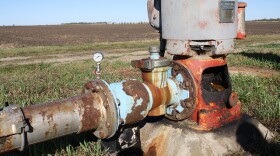If you’re not a proactive well owner, then you probably have no clue whether or not your well is at risk of going dry this summer. But that doesn’t have to be the case — at least not if you live in the Northern Sacramento Valley — because there’s a piece of paper that can help valley well owners better predict their groundwater situation.
It’s called a well log or a well completion report – and basically you can think of it as the well’s birth certificate that can help predict how a well should perform.
The most important piece of information on a well completion report is a well’s total depth. A well owner can gauge their groundwater situation by using the state’s online Water Data Library to compare that well depth to groundwater levels around them.
Allan Fulton is an Irrigation and Water Resources Farm Adviser for Colusa, Glenn, Tehama and Western Shasta counties.
“If you see that the groundwater levels are starting to drop to the bottom depth of your well you can begin to anticipate you’re going to have some problems,” he said.
He said well completion reports can be helpful in other ways too. Often times wells are mistakenly thought to be “dry” when really water has just fallen below the well’s pump. By comparing area groundwater levels with a well completion report that says where a pump sits …
“You possibly can set the pump deeper and restore your water supply,” a much cheaper fix than deepening the whole well, he said.
Now a special note should be made that monitoring wells are only found in the valley. That’s because in the foothills and mountains groundwater is stored in small pools between hard rock. This makes groundwater levels highly variable in those areas and pretty much impossible to screen for overall trends. So if you live in higher terrain – a well completion report isn’t really helpful.
If you live in the valley though, you can do the comparison. You just need the well completion report. To get one, first try the easy way. Contact your local Environmental Health Department. If they don’t have a report on file, then contact the state Department of Water Resources.

April Scholzen is the person who manages well completion report filings at DWR’s Northern Region Office. She said they have at least 80,000 reports on record for the North State, and even then they sometimes can’t find some. The property’s parcel number and the owner’s name at the time the well was drilled – are the two most critical pieces of information DWR needs to find a well completion report.
“If I had the parcel number and owners name at time of drilling I would say that 75 percent of the time I can find it with that," Scholzen said.
The property's parcel number can be easily obtained at the county assessor’s office, but the name of owner at time of drilling can be really hard to find because it involves a physical trip to the county recorder’s office. There you’ll have to sort through tons of property documents in an attempt to string together the property’s history of ownership, which can be sort of fun because you learn a lot about your property ...
“But it’s time consuming and it’s not always easy. And I feel bad having to ask that of people, but it’s what we need here," Scholzen said.
Because many wells are decades old and filing the well completion report happens at the time of drilling and is the responsibility of the well driller, many reports never actually get filed. For well owners with that issue, gauging their groundwater levels before a situation arrives will be nearly impossible – leaving them wondering if, and when, they’ll hear, the sputtering and spattering of the faucet.
How to be a proactive well owner
What to do if you're having issues with your well




